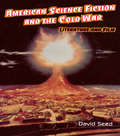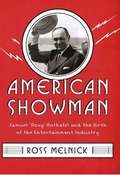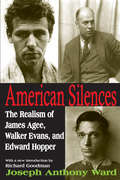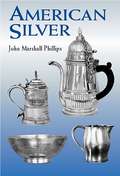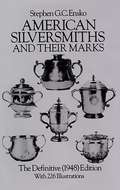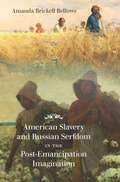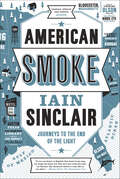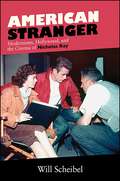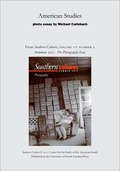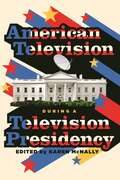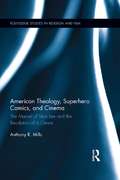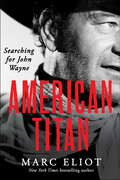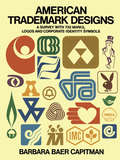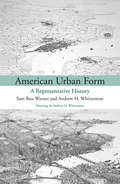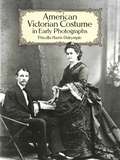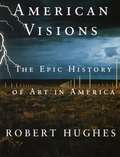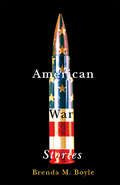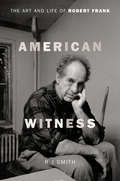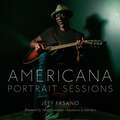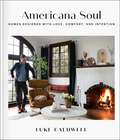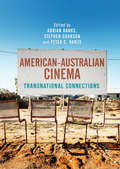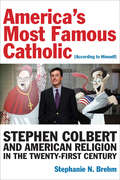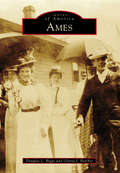- Table View
- List View
American Science Fiction and the Cold War: Literature and Film (America In The 20th/21st Century Ser. #Vol. 3)
by David SeedFirst Published in 1999. Routledge is an imprint of Taylor & Francis, an informa company.
American Showman: Samuel "Roxy" Rothafel and the Birth of the Entertainment Industry, 1908–1935 (Film and Culture Series)
by Ross MelnickSamuel "Roxy" Rothafel (1882–1936) built an influential and prolific career as film exhibitor, stage producer, radio broadcaster, musical arranger, theater manager, war propagandist, and international celebrity. He helped engineer the integration of film, music, and live performance in silent film exhibition; scored early Fox Movietone films such as Sunrise (1927); pioneered the convergence of film, broadcasting, and music publishing and recording in the 1920s; and helped movies and moviegoing become the dominant form of mass entertainment between the world wars. <P><P>The first book devoted to Rothafel's multifaceted career, American Showman examines his role as the key purveyor of a new film exhibition aesthetic that appropriated legitimate theater, opera, ballet, and classical music to attract multi-class audiences. Roxy scored motion pictures, produced enormous stage shows, managed many of New York's most important movie houses, directed and/or edited propaganda films for the American war effort, produced short and feature-length films, exhibited foreign, documentary, independent, and avant-garde motion pictures, and expanded the conception of mainstream, commercial cinema. He was also one of the chief creators of the radio variety program, pioneering radio broadcasting, promotions, and tours.The producers and promoters of distinct themes and styles, showmen like Roxy profoundly remade the moviegoing experience, turning the deluxe motion picture theater into a venue for exhibiting and producing live and recorded entertainment. Roxy's interest in media convergence also reflects a larger moment in which the entertainment industry began to create brands and franchises, exploit them through content release "events," and give rise to feature films, soundtracks, broadcasts, live performances, and related consumer products. Regularly cited as one of the twelve most important figures in the film and radio industries, Roxy was instrumental to the development of film exhibition and commercial broadcasting, musical accompaniment, and a new, convergent entertainment industry.
American Silences: The Realism of James Agee, Walker Evans, and Edward Hopper
by Joseph Anthony WardIn ""American Silences"", Joseph Anthony Ward offers a unique analysis of the use and effects of silence in modern American realistic art. Beginning with the nineteenth-century literature that laid the foundation for silence in art, he moves to a brief analysis of Sherwood Anderson's ""Winesburg"", Ohio and Ernest Hemingway's ""In Our Time"", showing how they, along with several other crucial works of twentieth-century American realism, incorporate the power of the silent into their expression without sacrificing the subjects and techniques of traditional realism. Examining ""Let Us Now Praise Famous Men"", James Agee's commentary on the life of tenant farmers, documented with photographs by Walker Evans, Ward traces the book's pattern of 'silence, then silence disturbed by sound, and ultimately silence restored'. Ward further supports his theory with a study of Agee's ""A Death in the Family"" and Evans' ""American Photographs"". Ward sees Agee's admiration of photography as a connection between the silence of the scenes he writes about and the silence of Evans' photographs. The use of silence is perhaps even more obvious in the paintings of Edward Hopper. Although throughout the book Ward suggests both the positive and negative qualities of silence in art, Hopper's paintings provide little in the way of postiveness. For Ward, the art of silence is an art of extreme concentration that seeks essences rather than superficiality that nearly transcends realism itself. The theme of silence in American realism is a significant new one, but Ward's interpretation of the prose and his analysis of the photographs and paintings, many of which are reproduced in this book, establish validity for art as the voice of silence.
American Silver
by John Marshall PhillipsA practical guide to recognizing, identifying, and appreciating the finest American silverwork. Photographs and drawings of masterworks from leading collections show some of the finest work by Jacob Hurd, Jeremiah Dummer, Peter van Dyck, Edward Winslow, John Coney, Paul Revere, and other renowned silversmiths. 52 halftones, 14 black-and-white line illustrations.
American Silversmiths and Their Marks: The Definitive (1948) Edition
by Stephen G. Ensko"So thoroughly is the American ethos embodied in the works of American silversmiths that it has given to their product a typical identity and it never can be mistaken for that of any other country." -- Charles Messer Stow in the Introduction.Forsaking the flourishes and ornamentation favored by their European contemporaries, early American gold- and silver smiths pioneered a new American aesthetic sensibility in creating for their well-heeled clients finely worked, luxurious metalware for the table, which was marked by a simplicity and forthrightness of design. These accomplished artisans have left us not only a stunning legacy of priceless silverware but also an opportunity to examine the culture, lifestyle, and values -- in short, the developing ethos -- of young America. For social and cultural historians as well as Americana buffs, the study of silversmithing in this book will provide a unique perspective on a spirited new nation. For serious connoisseurs of American gold and silver ware, silver dealer Stephen G. C. Ensko's American Silversmiths and Their Marks is a rich and definitive directory. Ensko has compiled an exhaustive list of over 3,000 gold- and silversmiths working between the years 1650 and 1850. Biographical details and location of their shops are given wherever possible. Maps of the great metropolitan centers of smithing (Boston, New York, and Philadelphia) with shop locations noted are appended. Over 200 of the finest examples of the work of early American artisans are displayed in sharp, clear black-and-white photographs. Items include tankards, cups, candlesticks, sugar boxes, inkstands, tea sets, porringers, plus a pitcher, sauce dish, teapot, and other works by famous New England patriot Paul Revere. The usefulness of this work is perhaps most apparent in the practical listing of identifying marks associated with gold- and silversmiths. With over 3,000 entries, this feature alone renders American Silversmiths and Their Marks indispensable to enthusiasts interested in tracking down and identifying antique pieces.
American Slavery and Russian Serfdom in the Post-Emancipation Imagination
by Amanda Brickell BellowsThe abolition of Russian serfdom in 1861 and American slavery in 1865 transformed both nations as Russian peasants and African Americans gained new rights as subjects and citizens. During the second half of the long nineteenth century, Americans and Russians responded to these societal transformations through a fascinating array of new cultural productions. Analyzing portrayals of African Americans and Russian serfs in oil paintings, advertisements, fiction, poetry, and ephemera housed in American and Russian archives, Amanda Brickell Bellows argues that these widely circulated depictions shaped collective memory of slavery and serfdom, affected the development of national consciousness, and influenced public opinion as peasants and freedpeople strove to exercise their newfound rights. While acknowledging the core differences between chattel slavery and serfdom, as well as the distinctions between each nation's post-emancipation era, Bellows highlights striking similarities between representations of slaves and serfs that were produced by elites in both nations as they sought to uphold a patriarchal vision of society. Russian peasants and African American freedpeople countered simplistic, paternalistic, and racist depictions by producing dignified self-representations of their traditions, communities, and accomplishments. This book provides an important reconsideration of post-emancipation assimilation, race, class, and political power.
American Smoke: Journeys to the End of the Light
by Iain SinclairThe visionary writer Iain Sinclair turns his sights to the Beat Generation in America in his most epic journey yet"How best to describe Iain Sinclair?" asks Robert Macfarlane in The Guardian. "A literary mud-larker and tip-picker? A Travelodge tramp (his phrase)? A middle-class dropout with a gift for bullshit (also his phrase)? A toxicologist of the twenty-first-century landscape? A historian of countercultures and occulted pasts? An intemperate WALL-E, compulsively collecting and compacting the city's textual waste? A psycho-geographer (from which term Sinclair has been rowing away ever since he helped launch it into the mainstream)? He's all of these, and more." Now, for the first time, the enigma that is Iain Sinclair lands on American shores for his long-awaited engagement with the memory-filled landscapes of the American Beats and their fellow travelers. A book filled with bad journeys and fated decisions, American Smoke is an epic walk in the footsteps of Malcolm Lowry, Charles Olson, Jack Kerouac, William Burroughs, Gary Snyder, and others, heated by obsession (the Old West, volcanoes, Mexico) and enlivened by false memories, broken reports, and strange adventures. With American Smoke, Sinclair confirms his place as the most innovative of our chroniclers of the contemporary.
American Stranger: Modernisms, Hollywood, and the Cinema of Nicholas Ray (SUNY series, Horizons of Cinema)
by Will ScheibelHow does cinema culture imagine one of its favorite figures, the rebel? The reputation of the American director Nicholas Ray provides a particularly notable example. Most famous for Rebel Without a Cause, Ray has since been canonized as a "rebel auteur" and celebrated for seeking a personal vision and signature style under the industrial pressures of Classical Hollywood during its late studio period. In American Stranger, Will Scheibel reconstructs how Ray's reputation developed over time, analyzing the different historical practices of modernism that set new horizons for artistic rebellion in postwar cinema.Drawing on biographical legends, interviews, film reviews, articles in both national newspapers and international film magazines, and star promotion and publicity, Scheibel examines the contexts in which Ray's reputation was constructed. These include the consolidation of director-based film criticism and the rise of film studies as an academic discipline; star performances and personifications of the rebel male in Ray's films; the counterculture in which Ray promoted himself as a teacher and worked as a political avant-gardist; and the art cinemas of Jean-Luc Godard, Wim Wenders, and Jim Jarmusch, each of whom were influenced by Ray. In addition to Rebel Without a Cause, Scheibel also analyzes such classic films as The Lusty Men and In a Lonely Place, as well as collaborative, less-examined films from his later career outside of Hollywood, We Can't Go Home Again and Lightning Over Water. Reconstructing the evolution of Ray's place in cinema culture, this intellectual history measures the standards for both rebellion and convention, for the vanguard and the establishment, that determine an artistic reputation.
American Studies: An article (Southern Cultures #17:2)
by Michael Carlebach<P>So often we see photographs of a humorless South, but Michael Carlebach reminds us to smile at ourselves. <P>This article appears in the Summer 2011 issue of Southern Cultures:The Photography Issue."Many years ago I concluded that for me truth and beauty, and perhaps wit and wisdom as well, are more likely to reside in what is ordinary and seemingly insignificant. This is, perhaps, a sideways look at America and American culture, but it is one that can produce moments that describe us all, but without makeup and bereft of a spokesperson."
American Television during a Television Presidency (Contemporary Approaches to Film and Media Series)
by Steven Cohan Donna Peberdy Oliver Gruner Hannah Andrews Simon Stow Kathryn Castle Michael Mario Albrecht Aimee Mollaghan Martin Murray Karen McNally Teresa Forde Gregory Frame K. Scott Culpepper Kwakiutl L. Dreher Jessica Ford Rafal Kus Dolores Resano Martin Zeller-JacquesIn American Television during a Television Presidency, Karen McNally and contributors critically examine the various ways in which television became transfixed by the Trump presidency and the broader political, social, and cultural climate. This book is the first to fully address the relationship between TV and a presidency consistently conducted with television in mind. The sixteen chapters cover everything from the political theater of televised impeachment hearings to the potent narratives of fictional drama and the stinging critiques of comedy, as they consider the wide-ranging ways in which television engages with the shifting political culture that emerged during this period. Approaching television both historically and in the contemporary moment, the contributors¾an international group of scholars from a variety of academic disciplines¾illuminate the indelible links that exist between television, American politics, and the nation’s broader culture. As it interrogates a presidency played out through the lens of the TV camera and reviews a medium immersing itself in a compelling and inescapable subject, American Television during a Television Presidency sets out to explore what defines the television of the Trump era as a distinctive time in TV history. From inequalities to resistance, and from fandom to historical memory, this book opens up new territory in which to critically analyze television’s complex relationship with Donald Trump, his presidency, and the political culture of this unsettled and simultaneously groundbreaking era. Undergraduate and graduate students and scholars of film and television studies, comedy studies, and cultural studies will value this strong collection.
American Theology, Superhero Comics, and Cinema: The Marvel of Stan Lee and the Revolution of a Genre (Routledge Studies in Religion and Film)
by Anthony MillsStan Lee, who was the head writer of Marvel Comics in the early 1960s, co-created such popular heroes as Spider-Man, Hulk, the X-Men, the Fantastic Four, Iron Man, Thor, and Daredevil. This book traces the ways in which American theologians and comic books of the era were not only both saying things about what it means to be human, but, starting with Lee they were largely saying the same things. Author Anthony R. Mills argues that the shift away from individualistic ideas of human personhood and toward relational conceptions occurring within both American theology and American superhero comics and films does not occur simply on the ontological level, but is also inherent to epistemology and ethics, reflecting the comprehensive nature of human life in terms of being, knowing, and acting. This book explores the idea of the "American monomyth" that pervades American hero stories and examines its philosophical and theological origins and specific manifestations in early American superhero comics. Surveying the anthropologies of six American theologians who argue against many of the monomyth’s assumptions, principally the staunch individualism taken to be the model of humanity, and who offer relationality as a more realistic and ethical alternative, this book offers a detailed argument for the intimate historical relationship between the now disparate fields of comic book/superhero film creation, on the one hand, and Christian theology, on the other, in the United States. An understanding of the early connections between theology and American conceptions of heroism helps to further make sense of their contemporary parallels, wherein superhero stories and theology are not strictly separate phenomena but have shared origins and concerns.
American Titan: Searching for John Wayne
by Marc EliotAs he did in his bestselling biographies of Cary Grant, Jimmy Stewart, and Clint Eastwood, Marc Eliot offers an exciting, groundbreaking new take on an American icon—the most legendary Western film hero of all time, John WayneAn audience favorite and top box-office draw for decades, John Wayne symbolized masculinity, power, and patriotism, and inspired millions of Americans. Yet despite his popularity and success, he was unfairly dismissed as a "B" movie actor lacking elegance, creativity, range, and depth. American Titan challenges conventional wisdom and reevaluates Wayne's life and vital cinematic legacy, ultimately placing the man known as "Duke" among a select and brilliant pantheon of "actor auteurs"—artists whose consistency of style in their work reflects their personal creative vision.In American Titan, Eliot demonstrates that Wayne possessed a distinct and remarkable vision rooted in his unique Midwestern and West Coast childhood that would become manifest in one of the most enduring screen personalities of all time: the elusive, stoic frontier loner. Wayne's heroic outsider also influenced a new generation of actors and filmmakers who would borrow from it to use in their own movies.Drawing on his deep, extensive knowledge of Hollywood and film, Eliot contends that the primary driving force behind Wayne's extraordinary career and body of work was the result of his own ambitions and his collaborations with directors John Ford and Howard Hawks. Eliot offers as evidence the distinct personality that runs through Wayne's staggering 169 films, from Stage Coach and The Searchers to The Quiet Man and The Green Berets.Setting Wayne's life within the sweeping political and social transformations that defined the nation, Eliot's masterly revisionist portrait is a remarkable in-depth look at a life that embodied the spirit of the twentieth century. What emerges is nothing less than a powerful understanding of and appreciation for a true American titan.Marc Eliot is the New York Times bestselling author of more than a dozen books on popular culture, among them the highly acclaimed Cary Grant, the award-winning Walt Disney: Hollywood's Dark Prince, and American Rebel: The Life of Clint Eastwood. He writes for a number of publications and frequently speaks about film at universities and to film groups, and on radio and television. He lives in New York City and Woodstock, New York.MarcEliot.net
American Trademark Designs
by Barbara Baer CapitmanArranged by category, these 732 American trademarks and symbols represent a variety of fields, including entertainment, education, real estate, insurance, food and beverages, retail, transportation, utilities, and heavy industry. The black-and-white images feature captions that identify the trademark, the year of design, and -- when known -- the designer's name.
American Urban Form: A Representative History (Urban and Industrial Environments)
by Sam Bass Warner Andrew WhittemoreAn illustrated history of the American city's evolution from sparsely populated village to regional metropolis.American Urban Form—the spaces, places, and boundaries that define city life—has been evolving since the first settlements of colonial days. The changing patterns of houses, buildings, streets, parks, pipes and wires, wharves, railroads, highways, and airports reflect changing patterns of the social, political, and economic processes that shape the city. In this book, Sam Bass Warner and Andrew Whittemore map more than three hundred years of the American city through the evolution of urban form. They do this by offering an illustrated history of “the City”—a hypothetical city (constructed from the histories of Boston, Philadelphia, and New York) that exemplifies the American city's transformation from village to regional metropolis.In an engaging text accompanied by Whittemore's detailed, meticulous drawings, they chart the City's changes. Planning for the future of cities, they remind us, requires an understanding of the forces that shaped the city's past.
American Victorian Costume in Early Photographs
by Priscilla Harris DalrympleOver 280 rare photographs document the clothing of ordinary men, women, and children from the 1840s through the 1890s, in what appears to be their Sunday best. Bustles, hoops, pantalets, shirtwaists, top hats, waistcoats, bowlers, other Victorian-era attire, as well as hairdressing and tonsorial styles. Introduction to fashions of each decade.
American Visions: The Epic History of Art in America
by Robert HughesWriting with all the brilliance, authority, and pungent wit that have distinguished his art criticism for Time magazine and his greatly acclaimed study of modern art, The Shock of the New, Robert Hughes now addresses his largest subject: the history of art in America. The intense relationship between the American people and their surroundings has been the source of a rich artistic tradition. American Visions is a consistently revealing demonstration of the many ways in which artists have expressed this pervasive connection. In nine eloquent chapters, which span the whole range of events, movements, and personalities of more than three centuries, Robert Hughes shows us the myriad associations between the unique society that is America and the art it has produced: "O My America, My New Founde Land" explores the churches, religious art, and artifacts of the Spanish invaders of the Southwest and the Puritans of New England; the austere esthetic of the Amish, the Quakers, and the Shakers; and the Anglophile culture of Virginia. "The Republic of Virtue" sets forth the ideals of neo-classicism as interpreted in the paintings of Benjamin West, John Singleton Copley, and the Peale family, and in the public architecture of Thomas Jefferson, Benjamin Latrobe, and Charles Bulfinch. "The Wilderness and the West" discusses the work of landscape painters such as Thomas Cole, Frederick Church, and the Luminists, who viewed the natural world as "the fingerprint of God''s creation," and of those who recorded America''s westward expansion--George Caleb Bingham, Albert Bierstadt, and Frederic Remington--and the accompanying shift in the perception of the Indian, from noble savage to outright demon. "American Renaissance" describes the opulent era that followed the Civil War, a cultural flowering expressed in the sculpture of Augustus Saint-Gaudens; the paintings of John Singer Sargent, Mary Cassatt, and Childe Hassam; the Newport cottages of the super-rich; and the beaux-arts buildings of Stanford White and his partners. "The Gritty Cities" looks at the post-Civil War years from another perspective: cast-iron cityscapes, the architecture of Louis Henri Sullivan, and the new realism of Thomas Eakins, Winslow Homer, the trompe-l''oeil painters, and the Ashcan School. "Early Modernism" introduces the first American avant garde: the painters Arthur Dove, Marsden Hartley, Joseph Stella, Charles Demuth, Charles Sheeler, and Georgia O''Keeffe, and the premier architect of his time, Frank Lloyd Wright. "Streamlines and Breadlines" surveys the boom years, when skyscrapers and Art Deco were all the rage . . . and the bust years that followed, when painters such as Edward Hopper, Stuart Davis, Thomas Hart Benton, Diego Rivera, and Jacob Lawrence showed Americans "the way we live now. " "The Empire of Signs" examines the American hegemony after World War II, when the Abstract Expressionists (Jackson Pollock, Willem de Kooning, Mark Rothko, et al. ) ruled the artistic roost, until they were dethroned by Jasper Johns, Robert Rauschenberg, the Pop artists, and Andy Warhol, while individualists such as David Smith and Joseph Cornell marched to their own music. "The Age of Anxiety" considers recent events: the return of figurative art and the appearance of minimal and conceptual art; the speculative mania of the 1980s, which led to scandalous auction practices and inflated reputations; and the trends and issues of art in the 90s. Lavishly illustrated and packed with biographies, anecdotes, astute and stimulating critical commentary, and sharp social history, American Visions was originally published in association with a new eight-part PBS television series. Robert Hughes has called it "a love letter to America. " This superb volume, which encompasses and enlarges upon the series, is an incomparably entertaining and insightful contemplation of its splendid subject.
American War Cinema and Media since Vietnam
by Patricia Keeton Peter SchecknerNo other cinematic genre more sharply illustrates the contradictions of American society - notions about social class, politics, and socio-economic ideology - than the war film. This book examines the latest cycle of war films to reveal how they mediate and negotiate the complexities of war, class, and a military-political mission largely gone bad.
American War Stories (War Culture)
by Brenda M. BoyleAmerican War Stories asks readers to contemplate what traditionally constitutes a “war story” and how that constitution obscures the normalization of militarism in American culture. The book claims the traditionally narrow scope of “war story,” as by a combatant about his wartime experience, compartmentalizes war, casting armed violence as distinct from everyday American life. Broadening “war story” beyond the specific genres of war narratives such as “war films,” “war fiction,” or “war memoirs,” American War Stories exposes how ingrained militarism is in everyday American life, a condition that challenges the very democratic principles the United States is touted as exemplifying.
American Witness: The Art and Life of Robert Frank
by Rj SmithFrom the author of the acclaimed James Brown biography The One comes the first in-depth biography of renowned photographer and filmmaker Robert Frank, best known for his landmark book The Americans.As well-known as Robert Frank the photographer is, few can say they really know Robert Frank the man. Born and raised in wartime Switzerland, Frank discovered the power and allure of photography at an early age and quickly learned that the art meant significantly more to him than the money, success, or fame. The art was all, and he intended to spend a lifetime pursuing it.American Witness is the first comprehensive look at the life of a man who's as mysterious and evasive as he is prolific and gifted. Leaving his rigid Switzerland for the more fluid United States in 1947, Frank found himself at the red-hot social center of bohemian New York in the '50s and '60s, becoming friends with everyone from Jack Kerouac, Allen Ginsberg, and Peter Orlovsky to photographer Walker Evans, actor Zero Mostel, painter Willem de Kooning, filmmaker Jonas Mekas, Bob Dylan, writer Rudy Wirlitzer, jazz musicians Ornette Coleman and Charles Mingus, and more. Frank roamed the country with his young family, taking roughly 27,000 photographs and collecting 83 of them into what is still his most famous work: The Americans. His was an America nobody had seen before, and if it was harshly criticized upon publication for its portrait of a divided country, the collection gradually grew to be recognized as a transformative American vision.And then he turned his back on certain success, giving up photography to reinvent himself as a film and video maker. Frank helped found the American independent cinema of the 1960s and made a legendary film with the Rolling Stones. Today, the nonagenarian is an embodiment of restless creativity and a symbol of what it costs to remain original in America, his life defined by never repeating himself, never being satisfied. American Witness is a portrait of a singular artist and the country that he saw.
American and Chinese-Language Cinemas: Examining Cultural Flows (Routledge Advances in Film Studies)
by Lisa Funnell Man-Fung YipCritics frequently describe the influence of "America," through Hollywood and other cultural industries, as a form of cultural imperialism. This unidirectional model of interaction does not address, however, the counter-flows of Chinese-language films into the American film market or the influence of Chinese filmmakers, film stars, and aesthetics in Hollywood. The aim of this collection is to (re)consider the complex dynamics of transnational cultural flows between American and Chinese-language film industries. The goal is to bring a more historical perspective to the subject, focusing as much on the Hollywood influence on early Shanghai or postwar Hong Kong films as on the intensifying flows between American and Chinese-language cinemas in recent decades. Contributors emphasize the processes of appropriation and reception involved in transnational cultural practices, examining film production, distribution, and reception.
Americana Portrait Sessions
by Jeff FasanoAmericana Portrait Sessions is the first photography book to take a comprehensive view of contemporary Americana music. The collection features intimate portraits that reveal the strength, heart, and soul of nearly two hundred great artists from the big tent that is Americana music, all shot through the expert lens of Jeff Fasano. Fasano's unparalleled access to Americana artists like Sheryl Crow, Rhiannon Giddens, Vince Gill, Keb' Mo', Judy Collins, John Oates, The Avett Brothers, The McCrary Sisters, Lucinda Williams, Margo Price, Blind Boys of Alabama, and Kris Kristofferson gives Americana Portrait Sessions the kind of authority that comes from true reach into the breadth of the genre. But this collection is as important for the artists few fans know as for the ones with successful careers behind them. While the book champions the diversity of race, gender, sexuality, and age inherent in Americana music, it also spans career arcs to bring lesser-known acts into the spotlight.Americana Portrait Sessions brings you backstage to the greenrooms and quiet corners where artists like The War and Treaty, Jewel, Jason Isbell, and The Wooten Brothers aren't just artists performing, but people hanging out.
Americana Soul: Homes Designed with Love, Comfort, and Intention
by Luke CaldwellEnter the world of Luke Caldwell, founder of the Timber and Love design and build firm and HGTV star of Boise Boys and Outgrown, as he shares his intentional design philosophy for creating timeless and organic home designs in this aspirational and accessible book.If you&’ve seen the popular HGTV shows Boise Boys and Outgrown, you&’ll know Luke Caldwell&’s passion for natural materials and comfortable spaces that are warm, inviting, livable, and beautiful at the same time. Now with Americana Soul, you can make those designs work for you. Organized by design style—Timber and Love, Natural and Organic, and Classic and Cozy—Luke&’s book is filled with photography that showcases the bones and flow of the spaces as well as the details that make them unique. Americana Soul showcases Luke&’s passion for design including curated personal collections and vintage finds, natural stone walls and fireplaces, and exposed wood beams, in a way that will inspire you to create your own.
American–Australian Cinema: Transnational Connections
by Peter C. Kunze Adrian Danks Stephen GaunsonThis edited collection assesses the complex historical and contemporary relationships between US and Australian cinema by tapping directly into discussions of national cinema, transnationalism and global Hollywood. While most equivalent studies aim to define national cinema as independent from or in competition with Hollywood, this collection explores a more porous set of relationships through the varied production, distribution and exhibition associations between Australia and the US. To explore this idea, the book investigates the influence that Australia has had on US cinema through the exportation of its stars, directors and other production personnel to Hollywood, while also charting the sustained influence of US cinema on Australia over the last hundred years. It takes two key points in time--the 1920s and 1930s and the last twenty years--to explore how particular patterns of localism, nationalism, colonialism, transnationalism and globalisation have shaped its course over the last century. The contributors re-examine the concept and definition of Australian cinema in regard to a range of local, international and global practices and trends that blur neat categorisations of national cinema. Although this concentration on US production, or influence, is particularly acute in relation to developments such as the opening of international film studios in Melbourne, Sydney, Adelaide and the Gold Coast over the last thirty years, the book also examines a range of Hollywood financed and/or conceived films shot in Australia since the 1920s.
America’s Most Famous Catholic: Stephen Colbert and American Religion in the Twenty-First Century (Catholic Practice In North America Ser.)
by Stephanie N. BrehmFor nine years, Stephen Colbert’s persona, “Colbert”—a Republican superhero and parody of conservative political pundits—informed audiences on current events, politics, social issues, and religion while lampooning conservative political policy, biblical literalism, and religious hypocrisy. As devout, vocal, and authoritative lay Catholics, religion is central to both the actor and his most famous character. Yet many viewers wonder, “Is Colbert a practicing Catholic in real life or is this part of his act?” America’s Most Famous Catholic (According to Himself) examines the ways in which Colbert challenges perceptions of Catholicism and Catholic mores through his faith and comedy.Religion and the foibles of religious institutions have served as rich fodder for scores of comedians over the years. What set “Colbert” apart on his Comedy Central show, The Colbert Report, was that his critical observations were made more powerful and harder to ignore because he approached religious material not from the predictable stance of the irreverent secular comedian but from his position as one of the faithful. He is a Catholic celebrity who can bridge critical outsider and participating insider, neither fully reverent nor fully irreverent.Providing a digital media ethnography and rhetorical analysis of Stephen Colbert and his character from 2005 to 2014, author Stephanie N. Brehm examines the intersection between lived religion and mass media, moving from an exploration of how Catholicism shapes Colbert’s life and world toward a conversation about how “Colbert” shapes Catholicism. Brehm provides historical context by discovering how “Colbert” compares to other Catholic figures, such Don Novello, George Carlin, Louis C.K., and Jim Gaffigan, who have each presented their views of Catholicism to Americans through radio, film, and television. The last chapter provides a current glimpse of Colbert on The Late Show, where he continues to be a voice for Catholicism on late night, now to an even broader audience.America’s Most Famous Catholic (According to Himself) also explores how Colbert carved space for Americans who currently define their religious lives through absence, ambivalence, and alternatives. Brehm reflects on the complexity of contemporary American Catholicism as it is lived today in the often-ignored form of Catholic multiplicity: thinking Catholics, cultural Catholics, cafeteria Catholics, and lukewarm Catholics, or what others have called Colbert Catholicism, an emphasis on the joy of religion in concert with the suffering. By examining the humor in religion, Brehm allows us to see clearly the religious elements in the work and life of comedian Stephen Colbert.
Ames (Images of America)
by Gloria J. Betcher Douglas L. BiggsAmes began as two communities. At its founding in 1864, Ames Station, on the Chicago & North Western Railway's main line, lay two miles east of Iowa Agricultural College, across the Squaw Creek. When the Ames & College Railway joined the college to the town in 1891, a cooperative spirit emerged that exists to this day. A rich history of achievements and colorful characters marks Ames's 150 years. One founding father commanded the 20th US Colored Infantry in the Civil War, while a Confederate veteran served as commander of the Iowa State College corps of cadets. Physicists at Iowa State College developed the uranium refinement process for the first atomic bomb and established the Ames Laboratory, the smallest US Department of Energy National Laboratory. Companies like Collegiate Manufacturing made material for the soldiers in World War II, and Kingland Systems now stands among global leaders in reference data software. Ames's businesses, citizens, and institutions, past and present, have created a rich community heritage for a vibrant, 21st-century city.
